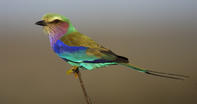
Name
Lilac-breasted roller (Coracias caudata)Appearance
The average lilac-breasted roller is 36-38 cm. The green head is large, the neck is short, the greenish-yellow legs are rather short and the feet are small. The black bill is strong and the eyes are brown. The chin is whitish, shading to a rich lilac on the breast.
The underparts are a greenish blue. The back and scapulars are brown. The shoulder of the wing, outer webs of the flight feathers and the rump are all violet.
The bases of the primaries and their coverts are a pale greenish blue and the outer tail feathers are elongated and blackish. The tail is narrow and of medium length.
Lilac-breasted Roller Diet
The lilac breasted roller eats grasshoppers, beetles, small amphibians, crabs and occasionally lizards. They take prey from the ground.Lilac-breasted Roller Breeding
The lilac-breasted roller builds an unlined nest in natural tree holes or termite hills. Sometimes they take over woodpecker’s or kingfisher’s nest holes. The female lay 2-4 white eggs, which are incubated by both parents for 22-24 days. At 19 days the chicks are fully feathered and a greyish brown.Lilac-breasted Roller Behaviour
Rollers get their name from their impressive courtship flight. It is a fast, shallow dive from a considerable height with a rolling or fast rocking motion, accompanied by loud raucous calls. Lilac-breasted rollers live in pairs or small groups but are often seen alone.
All rollers appear to be monogamous and highly territorial. They drive off many species from near their nest hole, even after breeding. They also temporarily defend small feeding territories; hence individuals are regularly spaced along roads.
The lilac-breasted roller is partly migratory, but in some areas they are sedentary. They will perch on a dead tree, surveying the area for prey.
Rollers swoop down next to their prey and eat it on the ground or return to a perch where they batter it before swallowing it whole. One typical aspect of its behaviour is that it also preys on animals fleeing from bushfires. It is a swift flyer and the call is a loud harsh ‘zaaak’.
Habitat
The lilac-breasted roller prefers grasslands, open woodlands, and regions where palm trees grow singly.Where they are found
The lilac-breasted roller is found more or less continuously throughout eastern and southern Africa from the Red Sea coasts of Ethiopia and northwest Somalia to the Angola coast and northern South Africa.
Lilac-breasted rollers inhabit acacia country with well-spaced trees, rolling bushy game lands, riverside areas, and cultivated land. They do not associate with human habitation.
 SouthAfrica.co.za provides informative, educational content on many South African bird species that orthologists and bird-watchers would enj...
SouthAfrica.co.za provides informative, educational content on many South African bird species that orthologists and bird-watchers would enj...